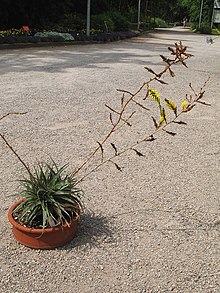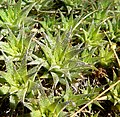Deuterocohnia
| Deuterocohnia | ||||||||||||
|---|---|---|---|---|---|---|---|---|---|---|---|---|

Deuterocohnia scapigera with long-tube, green flowers. |
||||||||||||
| Systematics | ||||||||||||
|
||||||||||||
| Scientific name | ||||||||||||
| Deuterocohnia | ||||||||||||
| Mez |
Deuterocohnia is a genus of plants in the subfamily Pitcairnioideae within the Bromeliad family (Bromeliaceae). The approximately 17 species occur in the South American Andes .
description






The Deuterocohnia styles are perennial , terrestrial or rarely lithophytic living xerophytes . They form strong, sprout roots. The stemless plants grow through Kindel to form clumps. The often thick, succulent leaves are in a basal, dense rosette . The leaf rosettes of species that were previously assigned to the genus Abromeitiella , only have a diameter and height of several centimeters; they form great cushions. The species according to the old, smaller extent of the genus Deuterocohnia form rosettes of leaves with a diameter of over 1 meter. The rigid leaves run out into a sharp point. At least the underside of the leaf has white scales ( trichomes ). The leaf margins are usually thorny-sawn, with thorns of very different sizes depending on the species.
The inflorescences lignify in some species and form several years flowers (for example Deuterocohnia brevispicata , which is about 2 meters long inflorescence of one specimen in culture blooms for about 20 years) - an exception in the family Bromeliaceae (comes only in the genus Hohenbergia ago ). The simple inflorescences or those made up of partial inflorescences are depending on the species only a few centimeters (i.e. compressed) up to more than 1 meter (with long inflorescence shafts) high. The radial symmetrical , threefold flowers are hermaphroditic with a double perianth . There are three sepals . The three free petals are yellow, yellow-green to green, rarely orange to red ( Deuterocohnia meziana ); they can be monochrome or two-tone. In some species the petals are curved back (for example Deuterocohnia recurvipetala , hence the specific epithet ). In all species the petals have appendages. There are two circles with three free, fertile stamens each. Three carpels have become a top permanent ovary grown.
The triple capsule fruits contain many seeds. The spindle-shaped seeds are laterally winged.
ecology
The Deuterocohnia species are mainly pollinated by hummingbirds . The seeds are dispersed by the wind.
Occurrence
The distribution area of the Deuterocohnia species is in the South American Andes . The main areas of distribution are the Andes in Peru, Chile, southern Bolivia and northern Argentina. They thrive on low-precipitation and radiation-intensive slopes and in dry valleys ( arid climate ).
Systematics
The genus Deuterocohnia was established in 1894 by Carl Christian Mez in Carl Friedrich Philipp von Martius: Flora Brasiliensis , Volume 3, Part 3, pp. 430 and 506. The type species is Deuterocohnia longipetala (Baker) Mez. The generic name Deuterocohnia honors the German botanist and microbiologist Ferdinand Julius Cohn (1828–1898). There was already a genus Cohnia , with the Greek prefix deuteros for "second" a new name was formed ( Cohnia Kunth today a synonym of Cordyline Comm. Ex R.Br. and Cohnia Rchb. F. Today a synonym of Oncidium Sw. ). Synonyms of Deuterocohnia Mez are Meziothamnus Harms and Abromeitiella Mez.
Seven species are listed in the generic monograph by Smith & Downs (1974–1979). Spencer & Smith (1992) assigned the species of the genus Abromeitiella to the genus Deuterocohnia . The systematics of this group was discussed controversially, a German research project ended in 2009 and confirmed the merging of the two genres. A revision of the genus Deuterocohnia took place in 2011 by Nicole Schütz.
In 2014 about 17 species belong to the genus Deuterocohnia :
- Deuterocohnia abstrusa (A.Cast.) N.Schütz (Syn .: Abromeitiella abstrusa A.Cast. , Abromeitiella lorentziana sensu Castellanos non (Mez) A.Cast. , Abromeitiella lorentziana sensu Smith & Downs non (Mez) A.Cast. ) : This new combination took place in 2011. Deuterocohnia abstrusa ismost similar to Deuterocohnia brevifolia . The herbarium that wasassigned to Abromeitiella lorentziana has proven to be a separate species Abromeitiella abstrusa . It thrives terrestrially in cushions in the Puna and "Andean Yungas" at altitudes of 1500 to 3200 meters in the Bolivian Department of Tarija and in the Argentine provinces of Jujuy, Salta, Tucumán, Catamarca and La Rioja.
- Deuterocohnia brevifolia (Griseb.) MASpencer & LBSmith (Syn .: Deuterocohnia lorentziana (Mez) MASpencer & LBSmith , Abromeitiella lorentziana (Mez) A.Cast. , Abromeitiella pulvinata Mez , Hepetis lorentziana (Mez) Mez , Pitcairnia lorentziana (Mez) Mez , Dyckia grisebachii Baker , Abromeitiella chlorantha (Speg.) Mez ): It thrives terrestrially and lithophytically at altitudes of 1000 to 3000 meters in the Bolivian department of Tarija and in the Argentinian provinces of Jujuy, Salta, Tucumán and Catamarca.
- Deuterocohnia brevispicata Rauh & L.Hromadnik : It thrives lithophytically and terrestrially in dry mountain forests and "Andean Yungas" at altitudes of 1200 to 2200 meters in the Bolivian departments of Chuquisaca and Cochabamba.
- Deuterocohnia chrysantha (Philippi) Mez It thrives lithophytically and terrestrially in the Atacama desert at altitudes of 20 to 800 meters in the Chilean region II = Antofagasta and region III = Atacama .
- Deuterocohnia digitata L.B.Smith : It thrives terrestrially at altitudes of mostly 2200 to 3200 meters, rarely up to 3800 meters, only in the Argentine province of Salta.
- Deuterocohnia gableana R.Vásquez & PLIbisch : It thrives lithophytically in dry mountain forests at altitudes of 1100 to 1200 meters only in the Bolivian department of Santa Cruz.
- Deuterocohnia glandulosa E. Gross : It thrives lithophytically and terrestrially in "Andean Yungas" at altitudes of 900 to 1200 meters in the Bolivian departments of Santa Cruz and Tarija.
- Deuterocohnia haumanii A.Castellanos : It thrives terrestrially at altitudes of rarely 500 to, mostly 1000 to 1900 meters in the Argentine provinces of Salta, Catamarca and Tucumán.
- Deuterocohnia longipetala (Baker) Mez : The wide, disjoint distribution area stretches from the Bolivian Department of Tarija to the Peruvian Departments of Amazonas, Cajamarca, Lambayeque and La Libertad to the Argentine provinces of Jujuy, Salta, Tucumán, Catamarca, Rioja del Estero, Juan, Córdoba, San Luis and Mendoza. It thrives terrestrially at altitudes of 250 to 1500 meters.
- Deuterocohnia lotteae (Rauh) MASpencer & LBSmith (Syn .: Abromeitiella lotteae Rauh ): It thrives lithophytically and terrestrially at altitudes of 1400 to 2700 meters only in the Bolivian Department of Tarija.
-
Deuterocohnia meziana Kuntze ex Mez : Since 2014, it contains four subspecies that occur from southeastern Bolivia through northern Paraguay to western Brazil and are adapted to very dry locations:
- Deuterocohnia meziana Kuntze ex Mez subsp. meziana (Syn .: Deuterocohnia divaricata Mez , Deuterocohnia paraguariensis Hassl. ): It thrives altogether at altitudes of 200 to 1400 meters, at relatively low altitudes on the eastern slopes of the Andes, in the lowlands of southeastern Bolivia in the Santa Cruz department and in neighboring areas in western Brazil and south along the Río Paraguay to northern Paraguay in the departments of Amambay and Concepción.
- Deuterocohnia meziana subsp. carmineo-viridiflora (Rauh) N.Schütz (Syn .: Deuterocohnia meziana var. carmineoviridiflora Rauh , Deuterocohnia carmineoviridiflora (Rauh) Gouda ): It received the rank of a species in 2012, but in 2014 the rank of a subspecies and is native to western Paraguay.
- Deuterocohnia meziana subsp. pedicellata (W.Till) Schütz (Syn .: Deuterocohnia pedicellata W.Till ): It was described as a separate species in 2005 and only occurs at altitudes of around 1200 meters in the Bolivian department of Chuquisaca .
- Deuterocohnia meziana subsp. vogtii N.Schütz : This subspecies was rewritten in 2014 from northern Paraguay and thrives in very low altitudes of 100 to 300 meters for this species.
- Deuterocohnia recurvipetala E.Gross : It grows at altitudes of 500 to 600 meters only in the Argentine province of Córdoba .
- Deuterocohnia sanctae-crucis (R.Vásquez & Ibisch) N.Schütz (Syn .: Deuterocohnia scapigera subsp. Sanctae-crucis R.Vásquez & PLIbisch ): It thrives lithophytically on rocky slopes in dry mountain forests and "Andean Yungas" at altitudes of 1200 to 2500 meters in the Bolivian departments of Cochabamba, Santa Cruz and Chuquisaca.
- Deuterocohnia scapigera (Rauh & L.Hromadnik) MASpencer & LBSmith (Syn .: Abromeitiella scapigera Rauh & L.Hrom. ): It thrives lithophytically on rocky slopes at altitudes of 2400 to 3300 meters in the Bolivian departments of Potosí and Chuquisaca.
- Deuterocohnia schreiteri A.Castellanos : It thrives lithophytically or terrestrially at altitudes of mostly 1000 to 2500 (850 to 2900) meters in the Argentine provinces of Salta, Tucumán and Catamarca.
- Deuterocohnia seramisiana R. Vásquez , PLIbisch & E. Gross : It thrives lithophytically or terrestrially at altitudes of 2000 to 2400 meters only in the Bolivian department of Chuquisaca.
-
Deuterocohnia strobilifera Mez (Syn .: Deuterocohnia bracteosa W.Till & L.Hromadnik ): The two varieties thrive terrestrially at altitudes of 2300 to 3900 meters:
- Deuterocohnia strobilifera var. Inermis L.B.Smith : It occurs in the Bolivian departments of Chuquisaca and Potosí. The leaf margin is smooth.
- Deuterocohnia strobilifera Mez var. Strobilifera : It is widespread in the Bolivian departments of Chuquisaca, Potosí and Tarija and in the Argentine province of Jujuy. The leaf margin is prickly serrate.
More pictures
Deuterocohnia meziana with large rosettes of leaves and long inflorescences on which flowers are formed over several years:
Deuterocohnia brevifolia , Syn .: Abromeitiella brevifolia , cushion-forming species with compressed inflorescences:
swell
- Werner Rauh : Bromeliads - Tillandsias and other culturally worthy bromeliads , Verlag Eugen Ulmer, Stuttgart 1990, ISBN 3-8001-6371-3 . (Section description)
- L. B Smith & RJ Downs: Pitcairnioideae (Bromeliaceae). In: Flora Neotropica. Monograph 14, Haefner Press, New York, 1974. Deuterocohnia pp. 231–242 (sections description and systematics)
- M. A Spencer & L. B Smith: A revision of the genus Deuterocohnia Mez (Bromeliaceae: Pitcairnioideae). In: Bradea , Volume 6, 16, 1992, pp. 141-146. (Section systematics)
- Ralf Horres: Dissertation, 2003: Investigations into the systematics and phylogeny of the Bromeliaceae with special consideration of molecular characteristics : Deuterocohnia pp. 22–23: Online. (PDF; 2.5 MB) (sections description and systematics)
- In “Species Index” click on Deuterocohnia in Eric J. Gouda, Derek Butcher & Kees Gouda: Encyclopaedia of Bromeliads , Version 3.1 (2012). last viewed on July 1, 2014 (sections systematics with distribution of species.)
- Nicole Schütz: Systematics and evolution of the genus Deuterocohnia Mez (Bromeliaceae) , dissertation, 2011 at the University of Kassel. Abstract , full text. (Sections Description, Distribution and Systematics)
Individual evidence
- ↑ a b c d e f g h i j k l m n o p q r s Nicole Schütz: Systematics and evolution of the genus Deuterocohnia Mez (Bromeliaceae) , dissertation, 2011 at the University of Kassel. Abstract , full text.
- ↑ Mezh 1894 scanned in at biodiversitylibrary.org .
- ↑ Jason R. Grant, 1998: On the Names of the Genera of the Bromeliaceae.
- ↑ a b c Nicole Schütz: Deuterocohnia meziana (Bromeliaceae): subspecies classification and the description of the new subspecies D. meziana subsp. vogtii from northern Paraguay. In: Phytotaxa , Volume 162, Issue 1, 2014. doi : 10.11646 / phytotaxa.162.1.2 Short preview - PDF.
- ↑ Harry E. Luther: An Alphabetical List of Bromeliad Binomials , 2008 ( Memento June 17, 2012 in the Internet Archive ) in The Marie Selby Botanical Gardens, Sarasota, Florida, USA. Published by The Bromeliad Society International. (PDF file; 314 kB)





